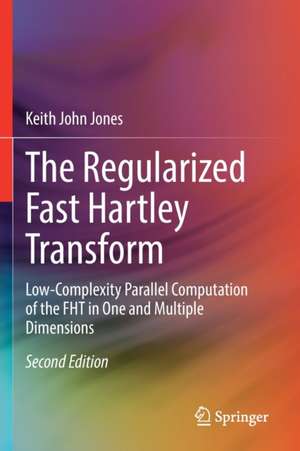The Regularized Fast Hartley Transform: Low-Complexity Parallel Computation of the FHT in One and Multiple Dimensions
Autor Keith John Jonesen Limba Engleză Paperback – 4 sep 2022
| Toate formatele și edițiile | Preț | Express |
|---|---|---|
| Paperback (1) | 728.91 lei 6-8 săpt. | |
| Springer International Publishing – 4 sep 2022 | 728.91 lei 6-8 săpt. | |
| Hardback (1) | 734.90 lei 6-8 săpt. | |
| Springer International Publishing – 3 sep 2021 | 734.90 lei 6-8 săpt. |
Preț: 728.91 lei
Preț vechi: 888.91 lei
-18% Nou
Puncte Express: 1093
Preț estimativ în valută:
139.52€ • 151.60$ • 117.27£
139.52€ • 151.60$ • 117.27£
Carte tipărită la comandă
Livrare economică 22 aprilie-06 mai
Preluare comenzi: 021 569.72.76
Specificații
ISBN-13: 9783030682477
ISBN-10: 3030682471
Pagini: 320
Ilustrații: XIX, 320 p. 57 illus.
Dimensiuni: 155 x 235 mm
Greutate: 0.48 kg
Ediția:2nd ed. 2022
Editura: Springer International Publishing
Colecția Springer
Locul publicării:Cham, Switzerland
ISBN-10: 3030682471
Pagini: 320
Ilustrații: XIX, 320 p. 57 illus.
Dimensiuni: 155 x 235 mm
Greutate: 0.48 kg
Ediția:2nd ed. 2022
Editura: Springer International Publishing
Colecția Springer
Locul publicării:Cham, Switzerland
Cuprins
Part 1: The Discrete Fourier and Hartley Transforms.- Background to Research.- The Real-Data Discrete Fourier Transform.- The Discrete Hartley Transform.- Part 2: The Regularized Fast Hartley Transform.- Derivation of Regularized Formulation of Fast Hartley Transform.- Design Strategy for Silicon-Based Implementation of Regularized Fast Hartley Transform.- Architecture for Silicon-Based Implementation of Regularized Fast Hartley Transform.- Design of CORDIC-Based Processing Element for Regularized Fast Hartley Transform.- Part 3: Applications of Regularized Fast Hartley Transform.- Derivation of Radix-2 Real-Data Fast Fourier Transform Algorithms using Regularized Fast Hartley Transform.- Computation of Common DSP-Based Functions using Regularized Fast Hartley Transform .- Part 4: The Multi-Dimensional Discrete Hartley Transform.- Parallel Reordering and Transfer of Data between Partitioned Memories of Discrete Hartley Transform for 1-D and m-D Cases.- Architectures for Silicon-Based Implementation of m-D Discrete Hartley Transform using Regularized Fast Hartley Transform.- Part 5: Results of Research.- Summary and Conclusions.
Notă biografică
Dr. Keith John Jones received his Ph.D in Computer Science from Birkbeck College, London University and his M.Sc in Applicable Mathematics from Cranfield Institute of Technology. He has an entry in “Who’s Who in Science and Engineering” (2008-present) and in “The Dictionary of International Biography” (otherwise known as “The Cambridge Blue Book”) (2008-present). He is currently a consultant at Wyke Technologies Ltd., Weymouth, Dorset (2015-present), having previously been employed as a mathematician/algorithmist/programmer & system designer for TRL Technology Ltd., Tewkesbury, Gloucestershire and, prior to that, for QinetiQ, Winfrith, Dorset. In 2010 he published “The Regularized Fast Hartley Transform: Optimal Formulation of Real-Data Fast Fourier Transform for Silicon‑Based Implementation in Resource-Constrained Environments”. He has 10 patents and has published extensively in the field.
Textul de pe ultima copertă
This book describes how a key signal/image processing algorithm – that of the fast Hartley transform (FHT) or, via a simple conversion routine between their outputs, of the real‑data version of the ubiquitous fast Fourier transform (FFT) – might best be formulated to facilitate computationally-efficient solutions. The author discusses this for both 1-D (such as required, for example, for the spectrum analysis of audio signals) and m‑D (such as required, for example, for the compression of noisy 2-D images or the watermarking of 3-D video signals) cases, but requiring few computing resources (i.e. low arithmetic/memory/power requirements, etc.). This is particularly relevant for those application areas, such as mobile communications, where the available silicon resources (as well as the battery-life) are expected to be limited. The aim of this monograph, where silicon‑based computing technology and a resource‑constrained environment is assumed and the data is real-valued innature, has thus been to seek solutions that best match the actual problem needing to be solved.
Caracteristici
Describes solutions to 1-D and m-D versions of the FHT and the real-data FFT targeted at applications Achieves the computational density of the most advanced commercially-available solutions for greatly reduced silicon resources Presents simple design variations that enable one to optimize the use of the available silicon resources
